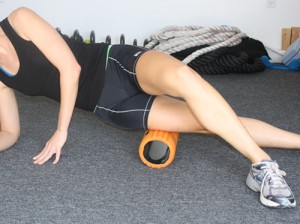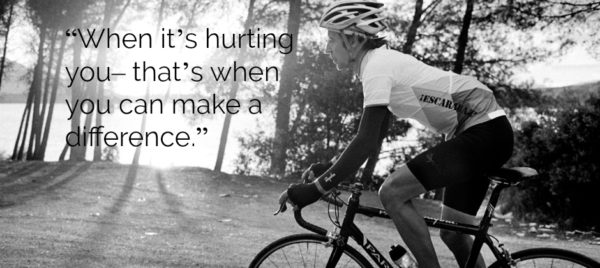Muscle pain plagues cyclists for many reasons. Beginners have the challenge of building muscles in areas they’ve never used so heavily before, and those training for a race or long ride must push their bodies even farther than usual to prepare. Forgetting to stretch can lead to a muscle injury, and pushing your body too hard can lead to some awful leg pain. Here are a few great ways to treat muscle aches and pains due to exercise.
Methods of Prevention
- Foam rollers: Shown in the image, foam rollers are a great way to loosen up tight muscles and relieve muscle aches. They are an especially good investment for a
 cyclist because of how tight cyclists IT bands can be. Using them on a regular basis helps keep your muscles healthy long term by loosening them up and increasing blood flow. They are also useful for treating pain, thanks to the increase in blood flow. More blood flow means more oxygen, which is needed for recovery, and less waste products that prolong soreness. Foam rollers can be a bit uncomfortable to use, but it’s worth it in the long run!
cyclist because of how tight cyclists IT bands can be. Using them on a regular basis helps keep your muscles healthy long term by loosening them up and increasing blood flow. They are also useful for treating pain, thanks to the increase in blood flow. More blood flow means more oxygen, which is needed for recovery, and less waste products that prolong soreness. Foam rollers can be a bit uncomfortable to use, but it’s worth it in the long run! - Supplements: While everyone experiences post-workout pain, preventing the problem is always better than treating it once it occurs. Antioxidants, vitamins, and amino acids have been shown to help reduce pain due to exercise. These are available in supplemental forms, but are also readily available in food. Fruit contains vitamins and antioxidants, tea contains lots of antioxidants, and red meat contains all of the essential amino acids. However, some people prefer specially formulated workout supplements, because there is an increased concentration of the specific amino acids and vitamins that prevent muscle soreness.
- Stretching: The importance of stretching cannot be emphasized enough. Before a bike ride, you should always warm up the muscles by walking and doing dynamic stretches. Dynamic stretching means that you are actively moving the muscles as you stretch them—examples include lunges and squats. Static stretching (being still and holding a stretch) is better left for after your ride.
Methods of Treatment
- Analgesic ointments: Icy Hot and Tiger Balm fall into the category of analgesic, or pain relieving, ointments. They function in similar ways, but do have some differences. Both use Menthol and Methyl Salicylate, which function to relieve pain in the area of application. Tiger Balm is commonly found in the form of ointments and patches, and Icy Hot is commonly found in the form of ointments and roll-on applicators. In addition to mild pain relief, these products dilate the blood vessels in the affected area to increase blood flow and speed up recovery. Lastly, they both interact with the temperature receptors in the area, creating a perception of warmth and/or cold. This helps distract the brain from the pain signals that it is receiving.
- Temperature therapy: Switching off between applying an ice pack for 20 minutes, and then a heating pad for 20 minutes, is a common and effective way to relieve muscle aches. Everybody does it a bit differently, but the rule here is to not leave either item on for more than 20 minutes. This method is often combined with rest, which is, of course, the best way to recover! Hot baths and ice baths are also useful alternatives, depending on the severity of the pain. Icy Hot mimics this in a way, since it creates the perception of cold and then hot in the affected area.
- Handheld massager: This method works best for mild to moderate pain. It can be used for treating muscle aches the same way that a foam roller works. It stimulates the tissue, which increases blood flow to the area; increased oxygen translates to faster recovery, and decreased waste and chemical irritants translates to decreased swelling and pain. It should be used on the aching area as needed, but should not cause discomfort. Too much pressure may contribute to the swelling rather than help relieve it. A heating pad and a handheld massager make a fantastic team- the heating pad increases blood flow and loosens up the muscle, and then the handheld massager does the rest of the work.
- Daily stretching: The most important thing for cyclists, and human beings in general, is to have a healthy range of motion and flexibility to move freely and efficiently. Stretching can aid in aligning the thick and thin muscles back into their ordered state after movement, as well as remove the lactic acid buildup that causes soreness.
If you’re looking to take the guesswork out of stretching, you can check out Dynamic Cyclist. This comprehensive resource addresses the most common muscle imbalances and adaptive muscle shortening that lead to pain and reduced performance on the bike. With just 15 minutes a day, you can follow along with the video programs to alleviate tension and improve posture, so you can ride pain free and reach your full potential on the bike. Don’t let muscle imbalances hold you back – click here to try 7 days free!
